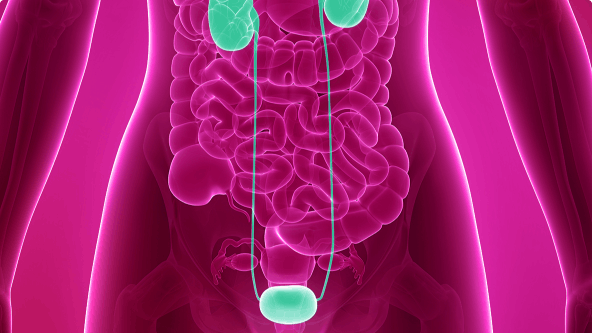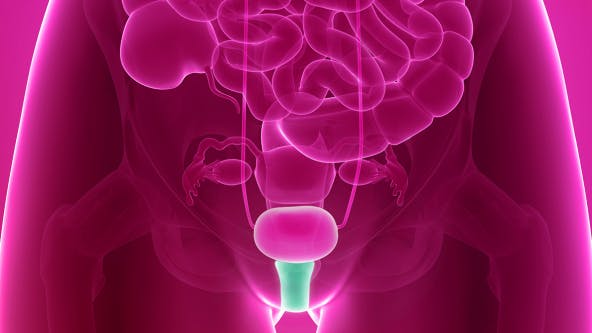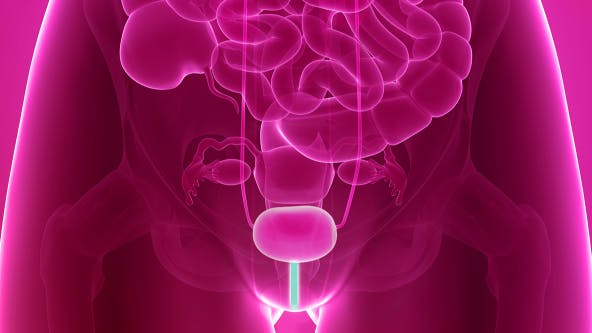00:00:00 - 00:03:58
ONSCREEN TEXT:
DIFFERENTIAL DIAGNOSIS
ONSCREEN TEXT:
Urinary Tract Infections
ONSCREEN TEXT:
UTI
NARRATOR:
The world of UTI…
ONSCREEN TEXT:
UTI
NARRATOR:
…may not be as simple as it seems.
ONSCREEN TEXT:
About 1 in 8 women experience a uUTI annually
uUTI=uncomplicated UTI.
NARRATOR:
About 1 in 8 women experience an uncomplicated UTI annually…
ONSCREEN TEXT:
uUTIs
>75%
Are caused by E. coli
NARRATOR:
…with more than 75% of uncomplicated UTIs caused by uropathogenic strains of Escherichia coli, also known as E. coli.
ONSCREEN TEXT:
UTI is common
Diagnoisis can be difficult
UTI=Urinary tract infection.
NARRATOR:
Despite urinary tract infection being so common, diagnosis can be difficult as the symptoms seen with UTI can also be seen with other conditions affecting the urogenital tract.
ONSCREEN TEXT:
uUTI vs. Complicated UTI
NARRATOR:
Let’s dive deeper.
Uncomplicated UTI, also called acute cystitis, is an infection of the bladder, or lower urinary tract, whereas pyelonephritis is an infection of the kidneys, or upper urinary tract, and is considered a complicated UTI.
ONSCREEN TEXT:
How uUTI differs from other causes of dysuria
- Occurs in otherwise healthy women
- Limited to the bladder/lower urinary tract
- Dysuria
- Urinary frequency or urgency
- Suprapubic pain
- Typically do not experience fever, flank pain or vaginal symptoms
NARRATOR:
Uncomplicated UTIs occur in otherwise healthy women and are limited to the bladder and lower urinary tract.
Patients often experience dysuria and urinary frequency or urgency, along with suprapubic pain. They typically do not experience fever, flank pain or vaginal symptoms.
ONSCREEN TEXT:
Complicated UTI
- Extends beyond the bladder to upper urinary tract
- Dysuria
- Fever (100.4°F/38°C)
- Chills, rigors
- Flank pain
- Costovertebral angle tenderness
- Malaise
- Nausea or vomiting
NARRATOR:
Complicated UTIs:
Extend beyond the bladder to the upper urinary tract. In addition to dysuria and urinary frequency and urgency, there may be:
- Fever
- Chills
- Flank pain
- Costovertebral angle tenderness
- Malaise, and
- Nausea or vomiting.
ONSCREEN TEXT:
uUTI symptoms can cause uUTI to be confused with other conditions such as
Vaginitis
Urethritis
NARRATOR:
Patients with uncomplicated UTI often experience symptoms such as dysuria that can be confused with other conditions, including vaginitis and urethritis.
ONSCREEN TEXT:
Vaginitis
- Limited to the vagina
- Dysuria without urinary frequency or urgency
- Presence of vaginal discharge or odor
- Puritus
- Dyspareunia
- Can be caused by bacterial vaginosis, vulvovaginal candidiasis, and trichomoniasis
NARRATOR:
Vaginitis is limited to the vagina and can include:
- Dysuria without urinary frequency or urgency
- The presence of vaginal discharge or odor
- Pruritus
- Dyspareunia
- And can be caused by bacterial vaginosis, vulvovaginal candidiasis, and trichomoniasis.
ONSCREEN TEXT:
Urethritis
- Limited to the urethra
- Dysuria in sexually active females
- Pyuria on urinalysis but no bacteriuria
- Can be caused by chlamydia, gonorrhea, trichomoniasis, Candida species, herpes simplex virus and irritants like contraceptive gel
NARRATOR:
Urethritis is a condition limited to the urethra and characterized by:
- Dysuria in sexually active females
- Pyuria on urinalysis but no bacteriuria
- And can be caused by chlamydia, gonorrhea, trichomoniasis, Candida species, herpes simplex virus, and irritants like contraceptive gel
ONSCREEN TEXT:
An estimated 30%-44% of women who have a uUTI are likely to have another, often within three months.
NARRATOR:
Women who have uncomplicated UTIs are also at risk for recurrence. An estimated 30-44% of women who have an uncomplicated UTI are likely to have another, often within three months.
ONSCREEN TEXT:
6 MONTHS
12 MONTHS
NARRATOR:
Recurrence is generally defined as 2 uncomplicated UTIs in 6 months or 3 in a year.
ONSCREEN TEXT:
Relapse
Recurrence with the same uropathogen within 2 weeks of finishing appropriate antibiotic therapy
Reinfection
Recurrence >2 weeks after successful treatment, even if the infecting uropathogen is the same as the original
NARRATOR:
Relapse and reinfection further define recurrence by their timing relative to the initial infection. Consider these definitions to help determine if your patient may be experiencing a relapse or a reinfection.
- Relapse is defined as a recurrence with the same uropathogen within 2 weeks of finishing appropriate antibiotic therapy.
- Relapse may require further investigation to determine the reason for failure of initial therapy.
- Reinfection is defined as recurrence more than 2 weeks after successful treatment, even if the infecting uropathogen is the same as the original.
ONSCREEN TEXT:
DIFFERENTIAL DIAGNOSIS
NARRATOR:
Knowing how uncomplicated UTI differs from other causes of dysuria can help guide the successful management of UTI.
ONSCREEN TEXT:
More To UTI
NARRATOR:
There may be more to UTI than you think.
ONSCREEN TEXT:
1. Uncomplicated urinary tract infections: developing drugs for treatment guidance for industry. Center for Drug Evaluation and Research. August 2019. Accessed June 17, 2023. https://www.fda.gov/regulatory-information/search-fda-guidance-documents/uncomplicated-urinary-tract-infections-developing-drugs-treatment-guidance-industry. 2. Complicated urinary tract infections: developing drugs for treatment guidance for industry. Center for Drug Evaluation and Research. June 2018. Accessed June 17, 2023. https://www.fda.gov/regulatory-information/search-fda-guidance-documents/complicated-urinary-tract-infections-developing-drugs-treatment. 3. Michels TC, Sands JE. Am Fam Physician. 2015;92(9):778-786. 4. American College of Obstetricians and Gynecologists. ACOG Practice Bulletin No.215. Obstet Gynecol. 2020;135(1):e1-e17. 5. Foxman B, Brown P. Epidemiology of urinary tract infections: transmission and risk factors, incidence, and costs. Infect Dis Clin North Am. 2003;17(2):227-241. 6. Hooton TM. NEJM. 2012;366(11):56-65. 7. Foxman B. The epidemiology of urinary tract infection. Nat Rev Urol. 2010;7(12):653-660. 8. Markowitz MA, Wood LN, Raz S, et al. Int Urogynecol J. 2019;30(7):1187-1194. 9. Gupta K, Hooton TM, Naber KG, et al. Clin Infect Dis. 2011;52(5):e103-e120. 10. Gupta K, Trautner BW. BMJ. 2013;346:f3140. 11. Anger J, Lee U, Ackerman LA, et al. Recurrent uncomplicated urinary tract infections in women: AUA/CUA/SUFU Guideline. American Urological Association. Published 2019. Updated 2022. Accessed April 2, 2023. https://www.auanet.org/guidelines-and-quality/guidelines/recurrent-uti. 12. Brubaker L, Carberry C, Nardos R, Carter-Brooks C, et al. Female Pelvic Med Reconstr Surg. 2018;24(5):321-335.
For US healthcare professionals.
Trademarks are owned by or licensed to the GSK group of companies.
[GSK brandmark logo]
©2023 GSK or licensor.
IDUVID230002 September 2023
Produced in USA.








